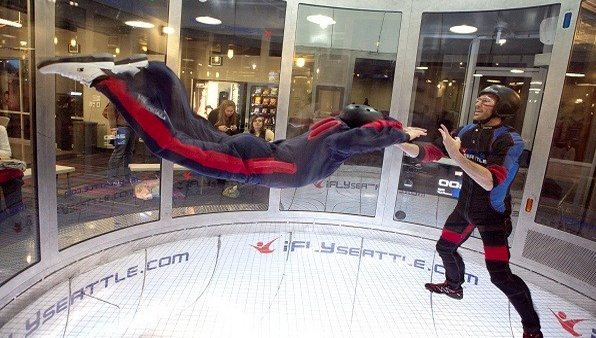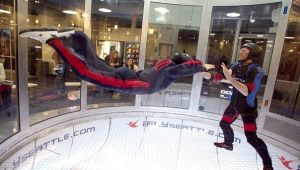Here is a fun and informative article from FLUKE ELECTRICAL NEWS that I’d like to share! Although I’ve never tried this, it looks to be a fantastic way to experience skydiving before jumping from 12,000 feet. Did you know… that as of October 24, 2014 the record for the highest parachute jump is 135,890 feet, just over 25 miles up. The jump was made by Google Senior VP, Alan Eustace.
Electrical systems power an all-glass vertical wind tunnel
Want to feel what it’s like to dive from a plane more than two miles above the ground . . . without a parachute? You can feel that and more at iFLY Seattle, and there’s no hard landing.
Here at the world’s first all-glass vertical wind tunnel, you and your pals can float like a butterfly for a minute or longer. iFLY Seattle is the fastest vertical wind tunnel (VWT) in the world and, at 14 feet (4.2 meters) in diameter and 90 feet (27.4 meters) top to bottom, the largest recirculating wind tunnel west of the Mississippi River.
The flight chamber is the enclosed section of the tunnel you step into. The floor of the flight chamber is a trampoline floor of aircraft-quality stainless steel. After you enter the flight chamber, the tunnel operator slowly brings the wind speed up until you and your instructor are airborne. And it’s not just for beginners, says iFLY owner Bill Adams. Spins, rolls, and precision team routines involving up to 10 fliers at a time can all be part of the experience. “There is no good skydiving team and no great skydivers that don’t spend a lot of time in the wind tunnel perfecting what they’re doing.”
The wind is generated from above, not below, the flight chamber. Powerful, high-efficiency axial fans are mounted in the upper leg of the tunnel (the optimum location for safety and efficiency). In most of the models iFLY uses, the wind is channeled and directed down the sides of the tunnel, underneath the flight chamber, and then up through the floor of the flight chamber, lifting flyers into the air. The air then travels through the top of the flight chamber, and the cycle begins again.
“If I could, I would spend hours in there,” said iFly owner Bill Adams. “It is the closest thing to flying and the most freeing experience ever. You weigh nothing, and the turning of your hand or your head makes you go any way you want.” See Adam and his friends in action.
Inspect and test
To keep those breezes blowing, Adams relies on Seattle’s Keithly Electric to perform a yearly preventive maintenance inspection of the electrical systems at the heart of the facility. These include four turbine-like fans above the flight chamber, each attached to a purpose-built, air cooled 400-hp Reliance Electric AC motor rated at 900 RPM and capable of bursts to 600 hp and 1125 RPM. These motors can draw air up past the flyers at speeds up to 230 mph, though most flying happens at 90 to 150 mph. The fans move more than two million cubic feet (fifty-six thousand cubic meters) of air per minute to create a wall-to-wall vertical cushion of air—just the right flow for flyers to float on. The air then recirculates through return ducts around the chamber.
LEARN MORE ABOUT TESTING PROCEDURES >>



